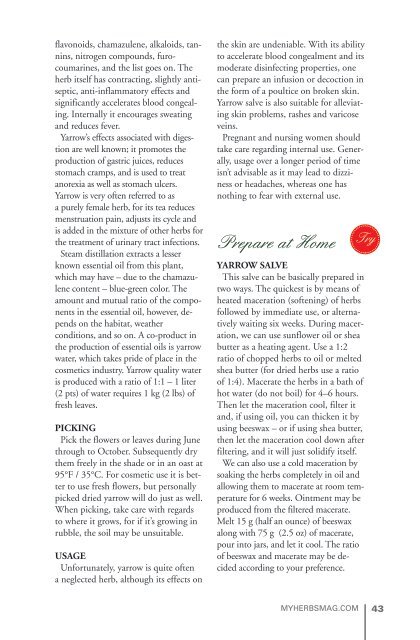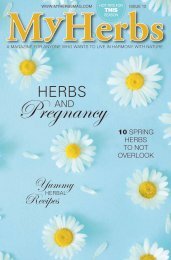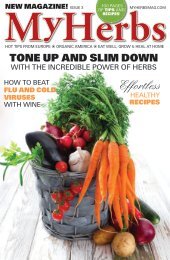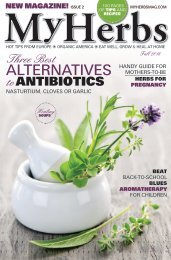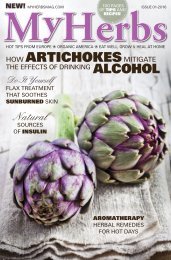My Herbs 1
Find out more on MYHERBS-STORE.COM. My Herbs is a special quarterly publication for anyone who is interested in alternative cooking, home grown herbs, and traditional or complementary medicine or healing methods, simply for everyone who wants to live in harmony with nature.
Find out more on MYHERBS-STORE.COM.
My Herbs is a special quarterly publication for anyone who is interested in alternative cooking, home grown herbs, and traditional or complementary medicine or healing methods, simply for everyone who wants to live in harmony with nature.
You also want an ePaper? Increase the reach of your titles
YUMPU automatically turns print PDFs into web optimized ePapers that Google loves.
flavonoids, chamazulene, alkaloids, tannins,<br />
nitrogen compounds, furocoumarines,<br />
and the list goes on. The<br />
herb itself has contracting, slightly antiseptic,<br />
anti-inflammatory effects and<br />
significantly accelerates blood congealing.<br />
Internally it encourages sweating<br />
and reduces fever.<br />
Yarrow’s effects associated with digestion<br />
are well known; it promotes the<br />
production of gastric juices, reduces<br />
stomach cramps, and is used to treat<br />
anorexia as well as stomach ulcers.<br />
Yarrow is very often referred to as<br />
a purely female herb, for its tea reduces<br />
menstruation pain, adjusts its cycle and<br />
is added in the mixture of other herbs for<br />
the treatment of urinary tract infections.<br />
Steam distillation extracts a lesser<br />
known essential oil from this plant,<br />
which may have – due to the chamazulene<br />
content – blue-green color. The<br />
amount and mutual ratio of the components<br />
in the essential oil, however, depends<br />
on the habitat, weather<br />
conditions, and so on. A co-product in<br />
the production of essential oils is yarrow<br />
water, which takes pride of place in the<br />
cosmetics industry. Yarrow quality water<br />
is produced with a ratio of 1:1 – 1 liter<br />
(2 pts) of water requires 1 kg (2 lbs) of<br />
fresh leaves.<br />
PICKING<br />
Pick the flowers or leaves during June<br />
through to October. Subsequently dry<br />
them freely in the shade or in an oast at<br />
95°F / 35°C. For cosmetic use it is better<br />
to use fresh flowers, but personally<br />
picked dried yarrow will do just as well.<br />
When picking, take care with regards<br />
to where it grows, for if it’s growing in<br />
rubble, the soil may be unsuitable.<br />
USAGE<br />
Unfortunately, yarrow is quite often<br />
a neglected herb, although its effects on<br />
the skin are undeniable. With its ability<br />
to accelerate blood congealment and its<br />
moderate disinfecting properties, one<br />
can prepare an infusion or decoction in<br />
the form of a poultice on broken skin.<br />
Yarrow salve is also suitable for alleviating<br />
skin problems, rashes and varicose<br />
veins.<br />
Pregnant and nursing women should<br />
take care regarding internal use. Generally,<br />
usage over a longer period of time<br />
isn’t advisable as it may lead to dizziness<br />
or headaches, whereas one has<br />
nothing to fear with external use.<br />
Prepare at Home<br />
Try<br />
YARROW SALVE<br />
This salve can be basically prepared in<br />
two ways. The quickest is by means of<br />
heated maceration (softening) of herbs<br />
followed by immediate use, or alternatively<br />
waiting six weeks. During maceration,<br />
we can use sunflower oil or shea<br />
butter as a heating agent. Use a 1:2<br />
ratio of chopped herbs to oil or melted<br />
shea butter (for dried herbs use a ratio<br />
of 1:4). Macerate the herbs in a bath of<br />
hot water (do not boil) for 4–6 hours.<br />
Then let the maceration cool, filter it<br />
and, if using oil, you can thicken it by<br />
using beeswax – or if using shea butter,<br />
then let the maceration cool down after<br />
filtering, and it will just solidify itself.<br />
We can also use a cold maceration by<br />
soaking the herbs completely in oil and<br />
allowing them to macerate at room temperature<br />
for 6 weeks. Ointment may be<br />
produced from the filtered macerate.<br />
Melt 15 g (half an ounce) of beeswax<br />
along with 75 g (2.5 oz) of macerate,<br />
pour into jars, and let it cool. The ratio<br />
of beeswax and macerate may be decided<br />
according to your preference.<br />
MYHERBSMAG.COM<br />
43


